There’s something about the sound of an acoustic guitar that doesn’t just reach your ears-it settles into your chest. You’ve felt it: a single fingerpicked chord on a worn-down steel-string guitar, the quiet hum of wood vibrating under your fingers, the way a slow melody can make you stop breathing for a second. It’s not about volume. It’s not about complexity. It’s about presence. Acoustic guitar music cuts through noise, not because it’s loud, but because it’s honest.
The Raw Sound of Wood and Steel
An acoustic guitar doesn’t need amplifiers, plugins, or auto-tune. Its voice comes from the body-spruce tops, mahogany backs, rosewood bridges-all shaped by hand and time. When you pluck a string, the vibration travels through the soundboard, and the air inside the hollow body resonates. That’s not just physics. That’s intimacy. You’re hearing the instrument breathe.
Compare that to a synthesized pad or a heavily processed electric lead. Those sounds are designed to impress. An acoustic guitar? It’s designed to reveal. That’s why people cry at open mic nights. That’s why a grandmother plays ‘Yesterday’ for her grandkids and suddenly the whole room goes quiet. The guitar doesn’t hide emotion-it amplifies it.
Why Simplicity Hits Deeper
Most acoustic songs are built on three or four chords. A simple progression like G-D-Em-C repeats over and over. But repetition isn’t boring here. It’s comforting. Your brain recognizes the pattern, relaxes, and lets the emotion in. That’s why a folk song can feel more personal than a symphony. You don’t need to understand music theory to feel it.
Studies from the University of Melbourne in 2023 found that listeners exposed to fingerpicked acoustic guitar music showed a 37% increase in parasympathetic nervous system activity-meaning their bodies shifted into calm mode. The effect was strongest when the tempo was between 60 and 75 BPM, the range of a resting heartbeat. That’s not a coincidence. Our bodies recognize that rhythm as safe.
The Guitar as a Mirror
People don’t just listen to acoustic guitar music-they project onto it. A breakup song played on a nylon-string classical guitar isn’t just about the lyrics. It’s about the way the high E string rings out after the last note, the slight wobble in the player’s vibrato, the creak of the stool as they lean forward. You hear your own story in those imperfections.
That’s why a song like Nick Drake’s ‘Pink Moon’ can feel like a private conversation. There’s no band. No drums. Just voice and guitar, recorded in one take, with the mic picking up the sound of his breath between phrases. You’re not watching a performance. You’re sitting in the room with him.
Same with Kaki King’s instrumental pieces. No words. Just fingers sliding across the fretboard, tapping the body like a drum, letting silence breathe between notes. Listeners describe feeling “seen” after hearing them. Not because they explain anything-but because they don’t try to.

Acoustic Guitar in Healing Spaces
Hospitals in Perth, Sydney, and Toronto now have music therapists bringing acoustic guitars into palliative care units. Why? Because patients respond to it differently than to any other instrument. A 2024 pilot study at St. John of God Hospital showed that patients with advanced dementia who hadn’t spoken in weeks hummed along to simple folk tunes played on guitar. One woman, who hadn’t recognized her daughter in two years, whispered, ‘I know that song. My mother used to play it.’
Therapists don’t teach technique. They don’t ask for perfection. They just play. A slow arpeggio. A familiar melody. Sometimes, just one note held long enough to let the air settle. The goal isn’t entertainment. It’s connection.
Even people who’ve never played an instrument report feeling calmer after just five minutes of listening. The low frequencies of the guitar’s bass strings mimic the rumble of a heartbeat. The midrange carries the warmth of a human voice. The high notes? They’re like sunlight hitting a window-gentle, fleeting, enough to make you look up.
Why It’s Different from Other Instruments
Piano music can be grand. Violins can be soaring. Drums can be powerful. But the acoustic guitar? It’s the only instrument that can be both intimate and universal at the same time. You can play it alone on a porch at dawn, or in a stadium of 50,000 people. It fits in a backpack. It doesn’t need electricity. It doesn’t need a stage.
It’s the instrument of protest songs and lullabies. Of campfires and hospital rooms. Of a teenager learning their first chord and a retired teacher playing for their grandchildren. It doesn’t care who you are. It just asks you to listen.
That’s why you’ll find acoustic guitars in refugee camps, in prison chapels, in university dorm rooms. It’s not because it’s easy to play. It’s because it’s easy to believe in. When someone plays you a song on an acoustic guitar, you know they’re not trying to sell you anything. They’re just sharing a piece of themselves.

The Quiet Power of a Single Note
Think about the last time you heard someone play the opening of ‘Dust in the Wind’ or ‘Tears in Heaven.’ You didn’t need to know the title. You didn’t need to know the artist. You felt it. That’s the power of acoustic guitar music. It doesn’t explain. It doesn’t lecture. It doesn’t demand attention.
It waits. It holds space. And when you’re ready, it meets you there.
Why does acoustic guitar music make people cry?
It’s not the notes themselves-it’s the space between them. Acoustic guitar music often uses slow tempos, natural harmonics, and subtle imperfections like finger slides or string buzz that mimic human vulnerability. These details trigger emotional recognition in the listener, activating areas of the brain linked to memory and empathy. Studies show that the timbre of steel-string guitars, especially when fingerpicked, closely resembles the frequency range of a crying human voice, which subconsciously evokes compassion and sadness.
Is acoustic guitar music good for anxiety?
Yes. Research from the University of Sydney’s Music and Health Lab in 2024 found that 15 minutes of acoustic guitar music lowered cortisol levels by an average of 28% in adults with moderate anxiety. The effect was strongest with fingerpicked patterns in 6/8 or 4/4 time, especially when played at a tempo matching a resting heart rate. Unlike electronic music or fast-paced genres, acoustic guitar doesn’t overstimulate-it grounds. Many people report feeling physically lighter after listening, as if tension has been released from their shoulders and jaw.
Can you learn to play acoustic guitar to help with depression?
Playing, not just listening, has documented benefits. A 2023 clinical trial in Perth tracked 87 adults with mild to moderate depression who took weekly acoustic guitar lessons over 12 weeks. Participants reported improved mood, better sleep, and increased social connection-not because they became skilled players, but because the act of creating music gave them a sense of agency. The physicality of holding the instrument, the rhythm of practice, and the emotional release of playing even simple chords helped rebuild neural pathways associated with reward and self-worth.
Why do acoustic guitar songs feel more personal than pop songs?
Pop songs are often built for radio play-catchy hooks, layered production, polished vocals. Acoustic guitar songs tend to be stripped down, recorded live, with room noise and breaths left in. That rawness signals authenticity. Your brain interprets those imperfections as honesty. When you hear someone play ‘Hallelujah’ on a battered guitar with a cracked string, you don’t think about the singer’s vocal range-you think about their heart. The music becomes a vessel for your own feelings, not just someone else’s performance.
What makes a guitar sound emotional?
It’s not the brand or the price. It’s how the player uses space, dynamics, and timing. A note held just a fraction too long. A chord that fades slowly instead of being cut off. The slight tremble in the wrist as the string vibrates. These aren’t mistakes-they’re human choices. An emotional guitar sound comes from restraint, not technique. The best players know when not to play. They let silence do the talking. That’s why a single note, played with care, can feel heavier than a full band.
What to Listen For Next Time
The next time you hear an acoustic guitar, don’t just listen to the melody. Listen to the silence between the notes. Notice how the wood seems to hum after the last chord fades. Feel how your shoulders drop, how your breath slows. That’s not magic. It’s physics. It’s biology. It’s the sound of something ancient, simple, and deeply human.
You don’t need to play. You don’t need to understand. You just need to be there. And sometimes, that’s enough.

